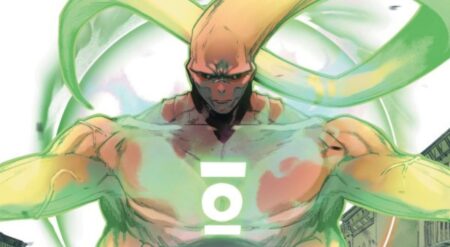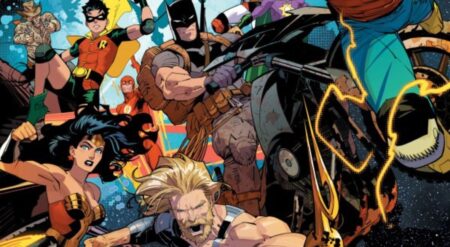
Published by DC Comics and written by Dan Jurgens with Rick Leonardi as penciler, Ande Parks on inks, Chris Sotomayor as colorist, with letters by Travis Lanham, Batman Beyond #33 continues the “Divide, Conquer, and Kill” arc that has been ongoing since issue number 31. With an extreme amount of hints that hinder the storytelling from the last issue, this one shows the McGinnis boys finally realizing that Bruce isn’t the grumpy old man they know.
The cover of Batman Beyond #33 is as telling as it is striking, with the last two issues setting up an apathetic and probably-really-not-Bruce, Bruce, a beaten Terry with his Cowl ripped, face up in the garbage, setting a bleak tone for the issue.
After two issues of the boys being beaten over the head with clues to not-Bruce’s real identity, it is refreshing to finally have both Matt and Terry making the connection – even if the circumstances are dire. Having been shown False Face’s Arkham cell early on in this arc, the narrative has been slow moving for the characters to catch up with the reader’s knowledge. That being said, Batman Beyond #33 finally finds a nice place in the arc to move past the setup and get into action and establish the rules for Bruce’s impersonator.
In Batman Beyond #33, we still get a little of Splitt action before all the unraveling of who not-Bruce really is. Up until this point, Splitt has been the main villain and if it wasn’t clear enough in the last issue, Batman is well out of his level. Truthfully, Splitt is a speedster who can also split themselves into their two halves, brothers Cadan and Adam. Without Bruce’s guidance or some back-up, there doesn’t seem to be a way to beat them.
While I do want to see more of Splitt, watching the McGinnis boys and Melanie finally realize the truth was great to see through the issue. Ultimately, the cringe-inducing not-Bruce is executed well, and Jurgens has saved the sleaziest of lines for him for this issue. On the other hand, Terry’s internal dialogue as Batman while fighting Splitt offers another piece to the Leonardi’s dynamic scene. Another high point of this issue is in the use of slightly transparent speech bubbles to denote that Spiltt is talking amongst themselves. It’s a small point that does a lot to drive home Splitt’s dual nature, if his costume didn’t do enough of that.
The one fault with this issue lays in the art of those not wearing suits. The action sequences between Batman and Splitt, as well as that between Melanie and Bruce in a straightjacket, are perfection. In contrast, the faces of Matt, Melanie, and Bruce all have moments where they look distorted, mainly due to the lack of expression lines on their faces, which works while masked and not so much when they’re just themselves.
Overall, Batman Beyond #33 has effectively pulled me back into this arc. Splitt remains an intriguing villain, not-Bruce is finally found out, and by giving the McGinnis boys a reveal, they establish some rules to False Face’s powers that open the door for more intriguing doppelgänging. With the ending of this issue moving the narrative in a new direction, the excitement for what comes next will keep me reading issues.






